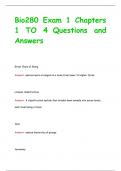Summary
Summary Industrial Psychology and Human Resource Management
- Institution
- University Of South Africa (Unisa)
These question and answer notes. Giving students an idea of what tests and assignments look like. It's helpful for students who struggle to understand basic concepts and terminology.
[Show more]












